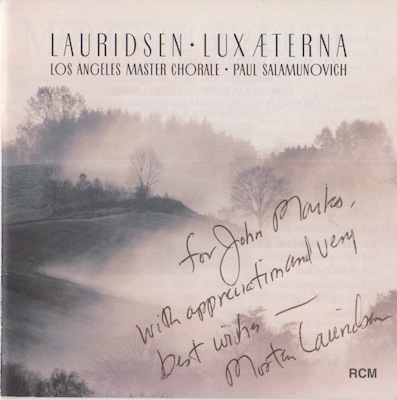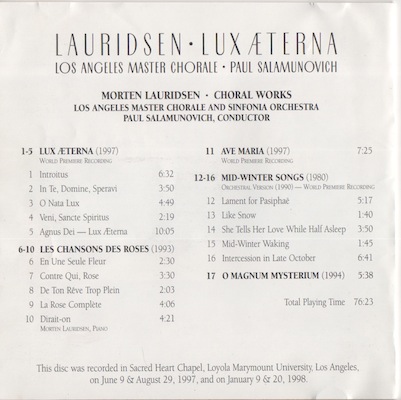
Morten Lauridsen: “Lux Æterna”

Morten Lauridsen: Lux Æterna and other works
Los Angeles Master Chorale and Sinfonia, Paul Salamunovich, conductor
CD Rubedo Canis Musica RCM 19705
Recorded June 1997 to January 1998, Sacred Heart Chapel, Loyola Marymount University, Los Angeles; Peter Rutenberg, producer; Fred Vogler, engineer.
This recording of Morten Lauridsen’s Lux Æterna was nominated for the Grammy award in its category in 1999. A quick listen to the beginning will tell you why. (A Robert Shaw CD won the award, understandably as it was the year of his death.) Lux Æterna starts with a stroke of genius, and then goes on from strength to strength. The first thing you hear is one of the tallest yet emptiest chords in concert music—the string basses lay down a granite foundation while the high strings harmonize from, it seems, light-years away. And there is nothing in between.
That inspired gesture announces the work as hugely ambitious, while being completely self-assured. Lauridsen is making his personal statement about the meaning of human existence, and nothing less than that. Lux Æterna is one of the masterpieces of the 20th century, and you are really missing out if you have not heard it.
Generous sound samples and more, after the jump.
Lux Æterna‘s opening is arresting indeed–one would be tempted to think that it could have been (consciously or unconsciously) influenced by the same bits of Mahler’s first and seventh symphonies that inspired the opening of Alexander Courage’s theme music for the Star Trek original television series (the part before the rhythm shifts uptempo).
But I think a closer match is from the third movement, “Dialogue du vent et de la mer,” of Debussy’s La Mer. About halfway through the final movement of La Mer (circa 4 minutes 8 seconds on the celebrated Charles Munch/Boston Symphony recording), at the direction “Plus calme et très expressif,” the harps re-enter, while the first violins play high artificial-harmonic long notes (they seem to be A-flat to me) while the string basses play very low notes. (Starting at five measures after rehearsal number 54.) And nothing in the middle. It might be pure coincidence, but I find it fascinating.
After Lux Æterna‘s opening chord, the orchestral strings and later winds sketch out a landscape in sound that always makes me think of what I call “Protestant Prairie Hymnody”—you probably will recognize that when you hear it. It reminds me of the sound-worlds of Roy Harris, Elmer Bernstein, and at times even Aaron Copland and Bela Bartok. Lux Æterna is tightly structured, but always sounds spontaneous. The pace changes, but there is always forward movement along the narrative arc.
Lux Æterna‘s theme is light, as a metaphor for hoped-for grace, leading to transcendence and redemption; and so it, along with Johannes Brahms’, is a non-liturgical Requiem. (And if I could choose only one for that Desert Island, it would be Lauridsen’s work and not Brahms’). The structural architecture of the two works is similar, although importantly, Lauridsen wrote only for chorus and not soloists. Lauridsen’s first and last movements are bookends; the central movement is an a-cappella motet, and the flanking movements provide contrasts in pace and feeling.
The recommended recording is not perfect, but on balance, it best captures the soul of the work. Strangely enough, for one of the most frequently performed pieces of 20th-century music for orchestra and chorus, there are only three commercially-available recordings, and only the recommended one is with full chorus and orchestra and not chamber choir and chamber orchestra, or chamber choir and organ. Both the other recordings have their own merits; but, the Los Angeles recording remains the gold standard. (At least until I win the Lottery and then hire Andris Nelsons and his merry cohorts.) The Los Angeles recording is available for streaming on Tidal, but a bit surprisingly, not on Steinway Streaming.)
Fear not over that Lux Æterna was written in the closing years of the 20th century–it is not “modern,” self-absorbed, trivial, or ugly. It is tonal, melodic, beautiful, and accessible. After much yearning and questing, the ending is quietly triumphal and uniquely satisfying. Musicologist Nick Strimple said of Morten Lauridsen:
[Lauridsen is] the only American composer in history who can be called a mystic;
whose probing, serene work contains an elusive and indefinable ingredient which
leaves the impression that all the questions have been answered.
 Photograph © Michael Stillwater, from the film
Photograph © Michael Stillwater, from the film
Shining Night: A Portrait of Composer Morten Lauridsen.
Note: While I have been concentrating on Lux Æterna, I should mention that the CD is very full indeed, and is the best introduction I know to Lauridsen’s works as a whole. The Chansons des Roses deal not with Heavenly aspirations, but with human love and its foibles; and the Mid-Winter Songs show Lauridsen’s adventurous or experimental side. Here’s the track listing:

On to the sound samples!
1a Lauridsen: Lux Æterna – Introitus (Orchestral Introduction)
1b Lauridsen: Lux Æterna – Introitus (Choral Entry)
2 Lauridsen: Lux Æterna – In Te, Domine, Speravi
3 Lauridsen: Lux Æterna – O Nata Lux
4 Lauridsen: Lux Æterna – Veni, Sancte Spiritus
5 Lauridsen: Lux Æterna – Agnus Dei – Lux Æterna
Please believe me; Lux Æterna is not a downer, let alone a sermon. It is a work that is full of joy. You must hear the whole thing!
# # #


